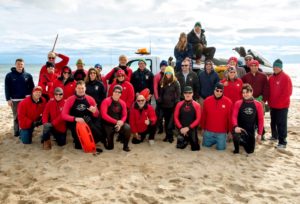NATIONAL BEACH SAFETY WEEK 2017
 Members of East Hampton Volunteer Ocean Rescue
Members of East Hampton Volunteer Ocean Rescue
United States Lifeguard Association’s Top Ten Safety Tips:
Learn to Swim – Promote the YMCA and the Junior Lifeguard Program. Swim Near a Lifeguard. Swim with a Buddy. Check with the Lifeguards on daily conditions. Obey Posted Signs and Flags – And know your location for 911 calls. Keep the Beach and Water Clean – What you pack in, pack out! Learn Rip Current Safety. Enter Water Feet First. Wear a Life Jacket when appropriate or mandated. Use Sunscreen and Drink Plenty of Water.United States Lifesaving Association Lightning Safety Guidelines:
- Beaches and bodies of water do not offer protection from lightning. Every year, lightning strikes and kills people on or near bodies of water. Most lightning deaths and injuries occur during the summer season. As a rule, lightning occurs most frequently within 10 miles of a thunderstorm, but bolts of lightning can travel as far as 20 miles away from the thunderstorm.
- “When Thunder Roars, Go Indoors!”
- Stop all activities and seek shelter in a solid building or hard-topped vehicle.
- Wait 30 minutes after storm to resume activities.
Rip Current Survival Tips:
Rip Currents can be killers. They are powerful, channeled currents of water flowing away from shore. The greatest safety precaution that can be taken is to recognize the danger of rip currents and always remember to swim at beaches with lifeguards.- Never Swim alone.
- Be cautious at all times. If in doubt, don’t go out!
- Swim at a lifeguarded beach whenever possible.
- Obey all instructions and orders from lifeguards.
- If caught in a rip, remain calm to conserve energy and think clearly.
- Don’t fight the current. Swim out of the current, parallel to the shoreline.
- If unable to swim out of the rip current, float or calmly tread water. When out of the current, swim towards shore.
- If still unable to reach shore, draw attention to yourself by facing the shore, waving your arms, and yelling for help.
- If you see a distressed swimmer, get help from a lifeguard or have someone call
- 9-1-1. Throw the victim something that floats and yell instructions on how to escape.
http://www.easthamptonoceanrescue.org
Lifeguards for life!


